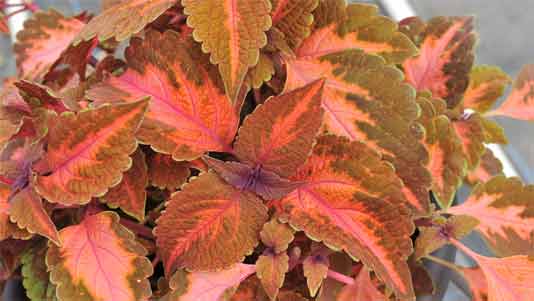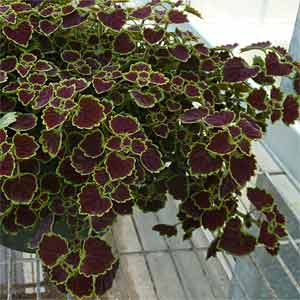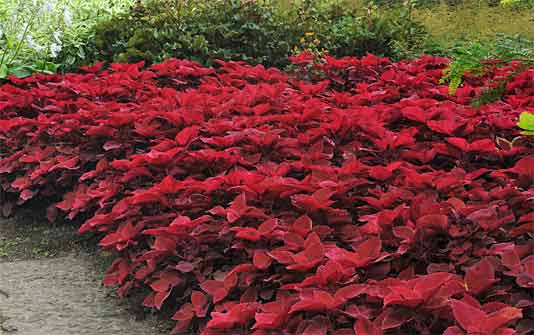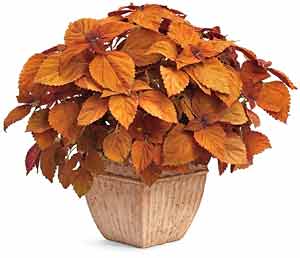






Many of the new coleus varities, such as Sunset Boulevard, feature warm colors.
From the National Gardening Bureau
GARDEN designers know that when it comes to annuals, it's not just about the flowers — foliage matters, too. And when it comes to foliage, coleus tops the list. Though it has fallen in and out of favor over the past couple of centuries, this member of the mint family is popular again, and the selection is better than ever.
Look for varieties that are labeled as sun-tolerant. Recommendations:
When breeders try to create new plants, the focus is often on new color combinations. In recent years, other considerations have become prominent, too:
The variability in patterns is amazing, with solid colors, splashes, blotches, streaks, flecks, margins and veins. Color intensity varies, depending on sunlight, heat sensitivity and other conditions. The term "sun coleus" refers to selections that tolerate more sun. The varieties with dark leaves tend to tolerate more sun, while lighter varieties need more shade to minimize leaf scorch. Morning sun and dappled afternoon shade tends to maintain consistent foliage coloration. Too little light will encourage a weak-stemmed, less vigorous plant without the best color.
Another variable to consider is leaf texture, which includes large, small, twisted, elongated, scalloped, lobed, finger-like, and "duck's foot" — they resemble webbed feet.

Burgundy Wedding Train is a trailing form, making it good for hanging baskets.
Coleus can be grouped into three plant forms: upright, rounded and trailing. Frequent snipping, pinching and trimming can help modify form although the trailing varieties have great value at the edge of a planter or in a hanging basket.
Coleus has long been considered a shade plant but the best leaf color is achieved with morning sun and some degree of afternoon shade. Many varieties do well in both shade and part-sun. Some can take quite a bit of sun as long as they are not allowed to dry out. Avoid overly damp soils, which can cause leaf drop and encourage disease. Plant coleus after danger of frost has passed when soil temperatures have warmed sufficiently and evening temperatures are above 60 degrees F. Feed plants regularly with a water-soluble fertilizer, especially if they are growing in containers.
To maintain plant form, pinch back every few weeks to prevent flower formation. Pinch just above a set of leaves or branching junction for the best appearance; don't leave a stub. Some gardeners leave the small flowers, but it's best to pinch them off to direct more energy into stem and foliage growth. Coleus left to flower may lose vigor as the plant puts energy into seed production.
Raising coleus from seed is relatively easy. Plan to sow them indoors, eight to 12 weeks before the last frost date in your area. Because seeds require light to germinate, sow them on the surface. Be sure to monitor water levels carefully. For best results, use a seedstarting system and read How to Start Seeds.
Overwintering coleus plants as houseplants is another way to get more plants. Temperatures near 70 degrees F. are required. Rotate plants and pinch back as needed to maintain form. Use grow lights to provide adequate light.

By planting a single variety, such as Redhead, you can get dramatic effects.
Use solid-color coleus varieties, such as Redhead and Lime Delight Premium Sun (both bred for the sun), to make a bold statement in the garden. Try multicolored varieites for "color echoes" that complement neighboring plants that have similar (or contrasting) flower and/or foliage colors. The repetition of certain coleus colors and form can lend unity and harmony in the garden. While a solitary specimen can add a "punch" of color, consider the impact of mass planting as well. Foliage with lighter colors can illuminate shady locations while dark colors in the same setting will create depth and contrast.

Sedona is part of the ColorBlaze series, which means it thrives in shade or part-sun. Upright plants grow 24-30" tall.
Coleus do well in pots and planters, as long as they are planted in free-draining potting soil, fertilized regularly and given the right amount of sun. Avoid windy locations because coleus can be prone to breakage. Feed regularly during the growing season, following the rate recommended on the package. Coleus do not show their best color if over-fertilized, so be conservative and consistent. You may want to consider self-watering planters, especially in sunny locations.
Coleus can be included in hanging baskets, too. Some of the trailing selections will flow nicely over the edge. Compact, bushy types can be used in the center of the basket. Keep in mind that coleus are thirsty and a hanging basket can dry out quickly — choose a self-watering basket for best results.
Founded in 1920, the National Garden Bureau is a non-profit organization whose mission is to improve the quality of life through increased use of seeds and plants.
Copyright © www.100flowers.win Botanic Garden All Rights Reserved